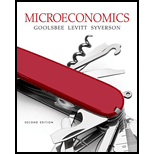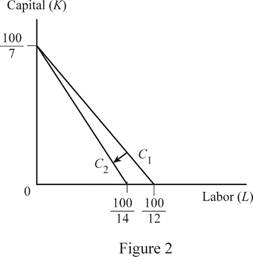
Concept explainers
(a)
The total cost function.
(a)
Explanation of Solution
In this case, the labor (L) costs $12 per hour and the capital (K) costs rent is $7 per hour. Now the total cost (TC) function can be represented as follows:
Thus, cost function is
Total cost: The total cost is the sum of firm’s fixed and variable costs.
(b)
The total cost function and the isocost line.
(b)
Explanation of Solution
If the producers wish to keep their total cost to exactly $100 then, the total cost function, given in part (a) can be used to find the equation for the isocost line of the firm.
Therefore, this is the equation for an isocost line corresponding to exactly $100 of costs. Is
Isocost line: An isocost line is a curve that shows all of the input combinations that yield the same cost.
(c)
The graphical representation of the isocost line.
(c)
Explanation of Solution
Maximum quantity of capital (When labor quantity is 0 units) can be calculated by substituting the respective values in Equation (1).
Thus, maximum quantity of capital is
Maximum quantity of labor (When capital quantity is 0 units) can be calculated by substituting the respective values in Equation (1).
Thus, maximum quantity of labor is
The Figure 1 illustrates the isocost line.

In Figure 1, the vertical axis shows the capital and the horizontal axis shows the labor where each point lies on the isocost line that shows all the possible input combinations that yield the same cost.
Isocost line: An isocost line is a curve that shows all of the input combinations that yield the same cost.
(d)
The vertical intercept and the horizontal intercept of the isocost line.
(d)
Explanation of Solution
In Figure 1, the vertical axis shows the different quantity of capital input used in the production process where the vertical intercept indicates the maximum quantity of capital that can be rented with the total cost of $100, without hiring labor.
The horizontal axis shows the different quantity of labor input used in the production process where the horizontal intercept indicates the maximum quantity of labor that can be hired with the total cost, here its $100, without renting for capital.
(e)
The slope of the isocost line.
(e)
Explanation of Solution
In Figure 1, each point lies on the isocost line that shows all the possible input combinations that yield the same cost where the slope of the isocost line indicates a negative sign
(f)
The new isocost line.
(f)
Explanation of Solution
In this case, the labor cost increases from $12 per hour to $14 per hour and the capital remains the same, $7 per hour. If the producers wish to keep their total cost to exactly $100 then, the new total cost function can be represented as follows:
Maximum quantity of capital (When labor quantity is 0 units) can be calculated by substituting the respective values in Equation (1).
Thus, maximum quantity of capital is
Maximum quantity of labor (When capital quantity is 0 units) can be calculated by substituting the respective values in Equation (1).
Thus, maximum quantity of labor is
The Figure 2 illustrates the new isocost line.

In Figure 2, the vertical axis shows the capital and the horizontal axis shows the labor when the relative prices of input changes, the isocost line rotates. In this case, the wage rises from $12 to $14. As a result, the initial isoquant line
Isocost line: An isocost line is a curve that shows all of the input combinations that yield the same cost.
Want to see more full solutions like this?
Chapter 6 Solutions
Microeconomics

 Principles of Economics (12th Edition)EconomicsISBN:9780134078779Author:Karl E. Case, Ray C. Fair, Sharon E. OsterPublisher:PEARSON
Principles of Economics (12th Edition)EconomicsISBN:9780134078779Author:Karl E. Case, Ray C. Fair, Sharon E. OsterPublisher:PEARSON Engineering Economy (17th Edition)EconomicsISBN:9780134870069Author:William G. Sullivan, Elin M. Wicks, C. Patrick KoellingPublisher:PEARSON
Engineering Economy (17th Edition)EconomicsISBN:9780134870069Author:William G. Sullivan, Elin M. Wicks, C. Patrick KoellingPublisher:PEARSON Principles of Economics (MindTap Course List)EconomicsISBN:9781305585126Author:N. Gregory MankiwPublisher:Cengage Learning
Principles of Economics (MindTap Course List)EconomicsISBN:9781305585126Author:N. Gregory MankiwPublisher:Cengage Learning Managerial Economics: A Problem Solving ApproachEconomicsISBN:9781337106665Author:Luke M. Froeb, Brian T. McCann, Michael R. Ward, Mike ShorPublisher:Cengage Learning
Managerial Economics: A Problem Solving ApproachEconomicsISBN:9781337106665Author:Luke M. Froeb, Brian T. McCann, Michael R. Ward, Mike ShorPublisher:Cengage Learning Managerial Economics & Business Strategy (Mcgraw-...EconomicsISBN:9781259290619Author:Michael Baye, Jeff PrincePublisher:McGraw-Hill Education
Managerial Economics & Business Strategy (Mcgraw-...EconomicsISBN:9781259290619Author:Michael Baye, Jeff PrincePublisher:McGraw-Hill Education





